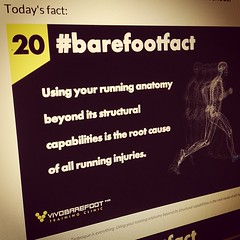| Using your running anatomy beyond its structural capabilities is the root cause of all running injuries. (Photo credit: VIVOBAREFOOT) |
One of the most common causes for running injuries is overuse. When you run too far, too fast, too many times you push your body beyond what it can handle and it rewards you with an injury. Common overuse injuries include muscle strains and sprains, joint pain like runner’s knee or shin splints, and sprained ankles and knees. You can even suffer from stress fractures in the bones of your feet, ankles and legs from overuse.
Tip #2: Avoid Dehydration
Cramps, side stitches, and abdominal distress are all caused by dehydration. Let your body become too dehydrated and you can also suffer from heart, lung, and muscle damage. Drink! Make sure you take in at least 4 ounces of water every fifteen minutes if you’re running for more than thirty minutes. And the warmer it is, the more you should drink.
Tip #3: Watch Where You’re Going
It may sound simplistic, but many injuries are caused by good old fashioned clumsiness. We’re talking about sprained ankles, broken bones, and torn cartilage. If you’re running in the dark, carry a flashlight or run in a well lit area. Running on trails? Watch where you’re going. The same goes for running on the sidewalk or in the road.
Tip #4: Wear Good Shoes (and socks)
Blisters are often the result of your shoes, or socks, causing friction on your foot. If you get blisters often try different types of socks. Wool socks often work well because they wick moisture away from your foot.
Make sure you have good shoes on too. Your shoes should correct for any foot strike issues and mechanics. Ideally, with the right shoe, your foot will strike the pavement head on and not roll to the inside or outside. When your foot rolls one direction or the other it puts unnatural stress on your joints, bones, and ligaments.
| (Photo credit: chuckwaters83) |
When you run do you lean forward at the waist? Do you swing your arms across your body? Do you take long strides and strike the ground with your heel? Each movement your body makes either makes running feel natural and easier or unnatural and harder. The trouble is that if you’ve been running or moving one way for a while it’s difficult to know if it’s the right way. Ask someone to watch you run or better yet, have them video tape you so you can see your running form. The optimal running form usually has a shorter stride, good posture and a nice relaxed arm swing that keeps your arms at your sides. Watch other runners to view their posture so you can begin to get a comparison.
There comes a time in most runners’ lives when they forget one of these five tips and suffer an injury. Hopefully, you won’t be one of those runners. There’s something to be said for an injury-free experience.



No comments:
Post a Comment